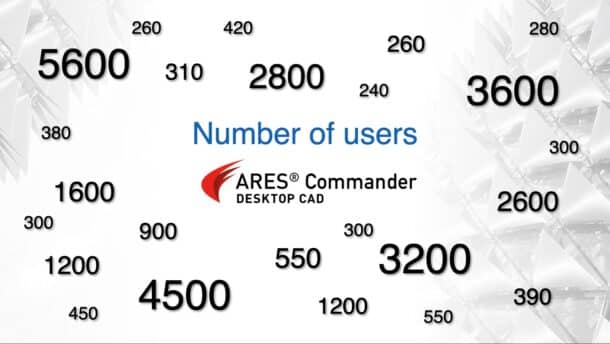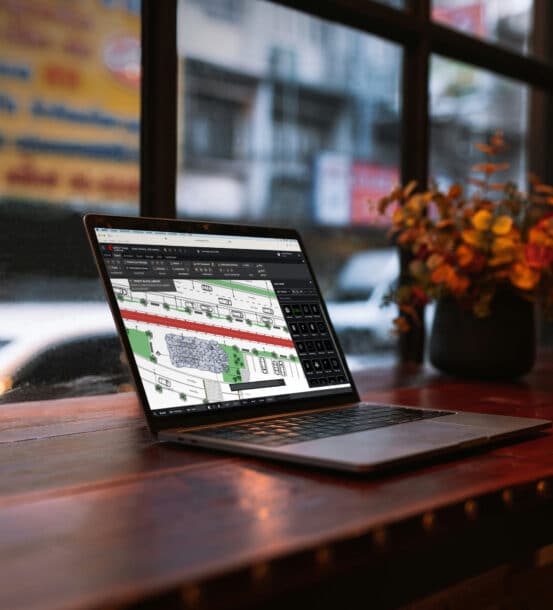THE END OF THE NETWORK LICENSE IS TURNING INTO A GAME CHANGER for thousands of CAD industry organizations. Many of those organizations are some of the biggest global brands in the world, including Hyundai and Samsung, while others are part of Japan’s Big Five construction industry companies. In each case, companies like LG and even the India Institute of Architects have left the world of Autodesk’s AutoCAD for Graebert’s ARES CAD platform.
All of this has turned into a significant win for the German CAD company and indicates broad market trends about CAD licensing, the push to subscription over perpetual, and, in this specific case, how the discontinuation of multiuser licenses for AutoCAD has boosted the market share of its leading challenger, ARES.
A Fair Price
As you likely understand if you are reading this, not all CAD users are equal. Some users accessing CAD through network licenses only work on files one day a week at most. Some fewer than that. So, what should be the fair price for such users?
To address the question of what a fair price for a CAD license is, all software companies must recognize that nearly all organizations have two classes (or sets) of CAD users. Some users work intensively on CAD every day or nearly every day. Others are more the opposite and access CAD rarely and at a lower level of competency and functional need. You can even argue that there is a third class of users who only need to access CAD files but do not modify them.
When you tie this into globalization, the pandemic, and the push to remote work, it is perfectly understandable how Autodesk’s timing on the elimination of multiuser network licensing and switching to named-user licensing would become a problem. Upon the announcement of the licensing changes, firms pushed back. They realized costs would scale from 2x to even 5x based on how they were leveraging multiuser network licenses with dozens to over a hundred users.
While no “open letter” emerged for AutoCAD users as it did for Revit users, due to resistance, Autodesk had to push back the transition to “named user licenses” several times.
In this context, and with the licensing change initiated in 2020, many organizations began to look seriously for native, compatible DWG CAD alternatives.
The Tipping Point in Asia
The elimination of the multiuser network AutoCAD license accelerated the coming tipping point in Asia. Graebert’s ARES platform was already well established in Japan once the network license was doomed for phaseout.
More than ten years ago, Graebert laid the seeds to displace both AutoCAD and other DWG rivals in Japan. Big Five construction leaders like Takenaka, Taisei, and Obayashi needed to reduce IT costs in other areas in order to support investment in BIM—with big investment plans in both Archicad and Revit BIM platforms. These companies found a budget for BIM by displacing AutoCAD for ARES with its much lower cost profile. That was the first step in Graebert’s plans.
Big Five construction leaders like Takenaka, Taisei, and Obayashi needed to reduce IT costs in other areas in order to support investment in BIM—with big investment plans in both Archicad and Revit BIM platforms.
Step two was to out-innovate Autodesk’s AutoCAD. The ARES platform did this in multiple ways, large and small, but two critical areas included ARES Touch for mobile DWG CAD on the construction site using iPads. Another important aspect was the delivery of an enterprise version of ARES for large IT requirements in complex organizations. Autodesk needed a quicker response to these challenges but was caught flat-footed; ARES Touch was deployed to over 5,000 iPads by two of Japan’s Big Five construction companies.
With this firm footing, ARES Commander desktop CAD began to spread out to over 24 large construction groups in Japan with 100+ network licenses. Again, these larger organizations have hundreds of CAD users who infrequently use CAD, and thus, the multiuser network license provides them flexibility and superior economics. These companies were not just investing in the “BIM movement” in Japan but, in more recent years, in other emerging technologies from drones, point clouds, robotics, and computational design. All of these emerging technologies—or “emtech”— required a growing slice of the overall IT budget. So, where could the funds come from? The answer was expensive AutoCAD licenses.

24 large Japanese construction industry (AEC) industry firms have now moved thousands of seats to ARES CAD. (Image: Graebert GbmH)
Going forward, large Japanese AEC companies began pushing AutoCAD out and installing ARES CAD instead. The number of licenses among just these 24 large Japanese construction (many full-stack AEC companies) was staggering. Take a look at the image above representing these 24 Japanese companies.
A Very Good Alternative
Graebert solved Japan’s construction industry 2D CAD problem by enabling large enterprises to continue leveraging a licensing model that worked for large numbers of CAD users who fit into two distinct classifications based on usage.
Then, the German CAD company solidified its reputation for world-class innovation by delivering enterprise and mobile capabilities that AutoCAD could not match. This made it difficult for companies to revert back to AutoCAD, so they re-doubled their commitment to Graebert and influenced smaller large companies and downstream users in Japan to also migrate to ARES.
This video from Graebert showcases ARES use at Toa Corporation in Japan. Click to play the full story.
To further strengthen its new-found hold on Japan’s AEC market, Graebert solved additional pain points by introducing FlexCloud licensing—a licensing technology that worked similarly to the network or multiuser license but was delivered via the cloud and thus was ideal for remote work in the post-pandemic context.
The Post-Covid World – A New CAD Order
The 2020 decision by Autodesk to phase out multiuser AutoCAD licenses was just one shock to large CAD-using organizations. The bigger shock was the global pandemic itself and the repercussions that emerged from it. Remote work became normalized around the world, and during the pandemic phase, technology stacks in companies of all sizes were suddenly exposed or exulted for their cloud technologies.
A key component of strong cloud technologies during the global pandemic was collaboration features, an area that ARES CAD solutions, with its Trinity features, possessed over its chief US-based rival. During the post-COVID era, “collaboration capabilities” have emerged as decisive product differentiators, so it is worth briefly describing what these are inside of the ARES Trinity capabilities.
Trinity Features
Graebert uses the word “Trinity” to define its ARES CAD ecosystem of solutions, spanning tools for desktop (ARES Commander), cloud-web (ARES Kudo), and mobile devices (ARES Touch). A license—like FlexCloud—that includes Trinity, therefore, means access to all the benefits of the entire ARES ecosystem.
A key aspect of ARES Trinity licenses is the inclusion of cloud-based collaboration features for working with multiple users and teams and not just access to ARES across all platforms and devices. A deep dive article on Trinity was published back in 2023, and it went through collaboration features such as the synchronization of files and how they are accessed and shared in teams, how multiple users and stakeholders can do comments and markups and get email notifications, and how version history works.

ARES Trinity version 2025 in this image. Trinity licenses enable access to DWG CAD on all three platforms (desktop, web, and mobile) across Windows, MacOS, iOS, and Android. (Image: Graebert GbmH).
Additionally, Trinity features enable powerful user access and rights controls, how session handling works to prevent loss of data when multiple users or even the same user works on the same file from different machines, and how sharing View-only links empowers workflows with different types of project stakeholders.
Finally, a key part of ARES Trinity is the Trinity Block Library, which is where common blocks can be shared among collaborators working on files. Again, our previous feature covered Trinity in-depth, and a newer feature here touched on the Trinity Block Library.
Some readers may contend that other DWG competitors, including AutoCAD, have most of these features or a better feature. That may be true, but they don’t have all of these features at the level of depth and execution that ARES has.
Secure Remote Access to Files
ARES Trinity has the most secure and extensive cloud-based access to files. Not only do users have ARES Cloud as a storage option, they have the industry’s largest set of possible connections, including Google Drive, Microsoft OneDrive and OneDrive for Business, Box, Dropbox, Microsoft SharePoint, and specialist industry clouds, including OnShape (MCAD industry) and Trimble Connect (AEC industry). There is also WebDAV support, Amazon’s AWS, and the enterprise capability to connect with private clouds.
Regardless of which cloud(s) you select to work with and store your files, Trinity’s synchronization and collaboration features work across all of them, with the session handling features managing potential conflicts and enabling multiple users to work on the same files. If a user has control over a file, any other user can only open that file in View-only mode, but commenting is always active, enabling near-real-time collaboration.
Enterprise Features
The ability of ARES Trinity to work with Amazon AWS, WebDAV, and private clouds is part of its enterprise strengths, but not its only enterprise features.
For example, in Japan, Big Five construction giant Taisei deployed over 4,000 iPads with ARES Touch on them and ARES for Enterprise features support for Microsoft’s Intune to deploy and manage applications available on the company’s fleet of iPads.
MORE: Japanese AEC Giant Selects Graebert ARES CAD Technologies — Learn Why
Taisei also leveraged ARES Enterprise support for SSO (single-sign-on) via Microsoft ADFS (Active Directory Federation Services) to authenticate its users, and this included access to Microsoft OneDrive, where the construction giant stores its files. Using this system, users logged in using SSO via ADFS, which gave them access to any company solution on any iPad. Moreover, the Enterprise version of ARES Touch prevents users from accessing any other unauthorized cloud storage provider, adding a level of security to the solution.
Importantly, ARES for Enterprise licenses monitors the system for active users, not specific users. Autodesk simply hasn’t matched the extent of these security and enterprise features, even today.
ARES Kudo
Finally, it should be emphasized that ARES Trinity licenses include ARES Kudo, the web browser-based version. In a recent feature article, we found that in nearly every comparable category, ARES Kudo in the browser was competitive with AutoCAD LT, with the exception of the performance of large files.

ARES Kudo has all the essential features of AutoCAD LT but runs fully in the web browser. This flexibility means access to critical enterprise CAD files when traveling, visiting job and client sites, or just working briefly from a nearby coffee cafe. (Image: Graebert GbmH).
With such an extensive array of competitive advantages and unique capabilities—and unrivaled features for very large organizations—it was not surprising to learn recently that massive global giants in Korea have left AutoCAD for ARES CAD as well.
Displacement at LG, Samsung, and Hyundai Steel
Graebert is now touting South Korea’s industrial giants as new ARES customers with large-scale displacements of AutoCAD licenses.
Those giant organizations, as in many global giants in Asia, conduct benchmarks in a point-weighted system to evaluate the digital solutions under consideration. What they do not do is tell the software companies under evaluation exactly how their applications faired under their benchmark evaluation system, only if their applications prevailed.
In the case of ARES sales in South Korea, for Hyundai Steel, Hyundai Mobis, LG, and Samsung, the German DWG CAD solution prevailed and displaced hundreds of AutoCAD seats in these enterprise giants. And this is just the latest in a wave of large-scale displacements of AutoCAD for ARES CAD across Asia.
Conclusions
Whether in Japan or South Korea, Graebert is able to offer large CAD organizations the licensing options that Autodesk was no longer willing to offer, and this played right into Asia’s cultural preferences for working with flexible partners. This also included perpetual licensing options alongside Graebert’s newer cloud-based subscription licenses (FlexCloud).

Toa Corporation, a large enterprise-class construction company in Japan, valued the flexible network licensing that Graebert of Germany was willing to provide. This is one critical reason why the Japanese AEC giant moved to ARES CAD. The company also hopes to see more BIM/CIM capabilities in future ARES CAD releases.
Flexibility, while critical, isn’t the only motive for switching out AutoCAD for ARES CAD. The economic value Graebert delivers is now simply too large, and the impacts on Autodesk have been felt in Asia CAD markets. Today, in certain markets like Japan, Autodesk sells full versions of AutoCAD for the price of AutoCAD LT as a way to better compete with ARES CAD.
In the final analysis, Autodesk currently can’t match a combination of economic value, licensing flexibility, enterprise features, and technical advantages that have led to massive market share gains in Asia by Graebert with its ARES CAD ecosystem. Now, the German CAD giant is looking at the North American AutoCAD market with similar aims.



